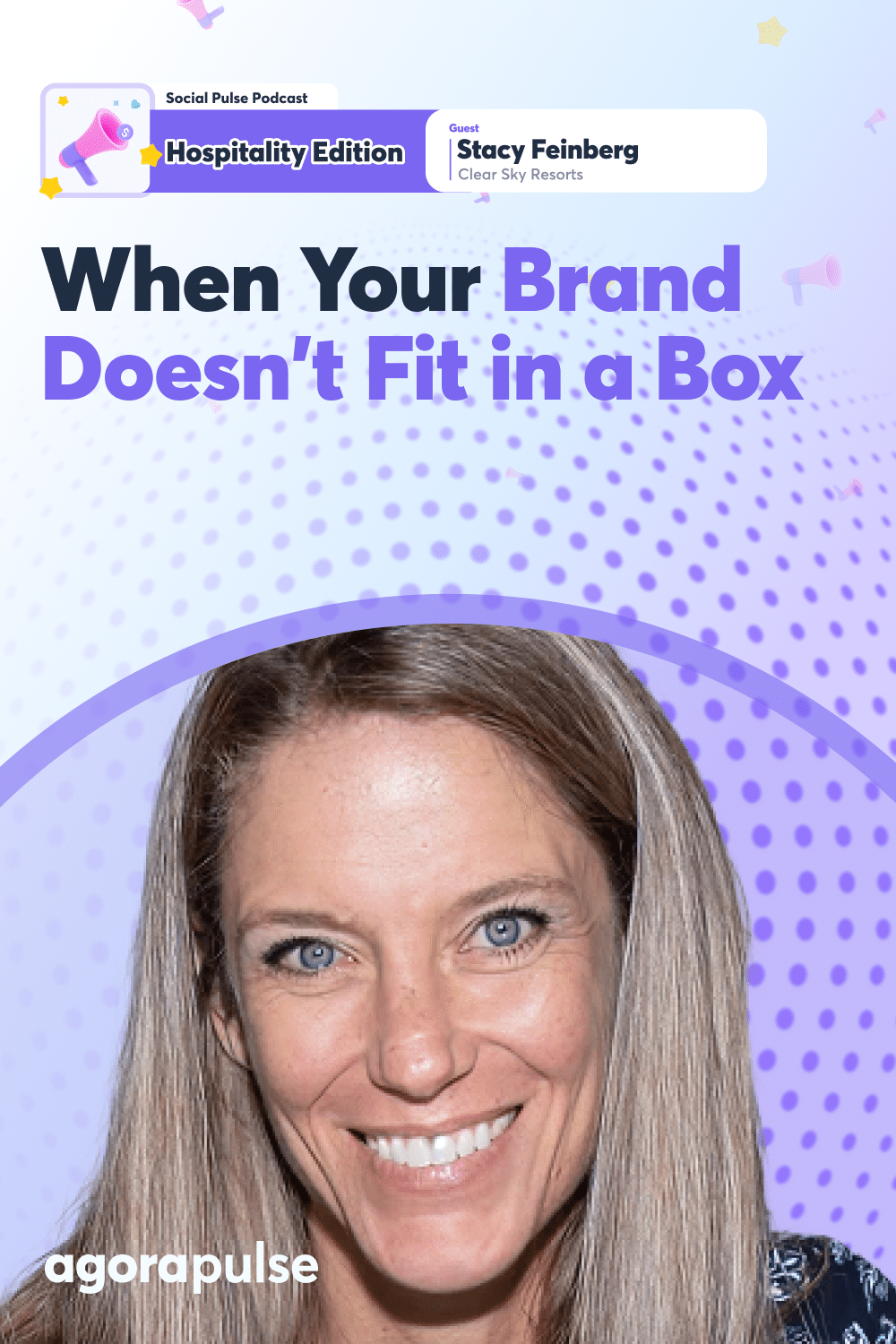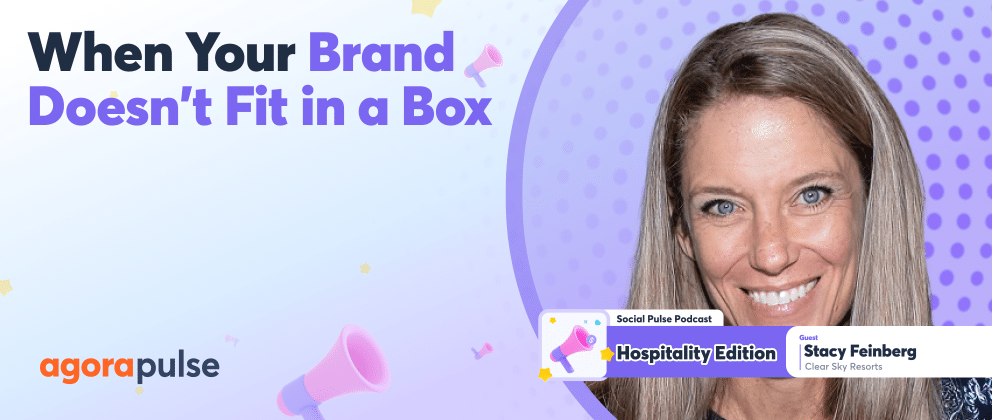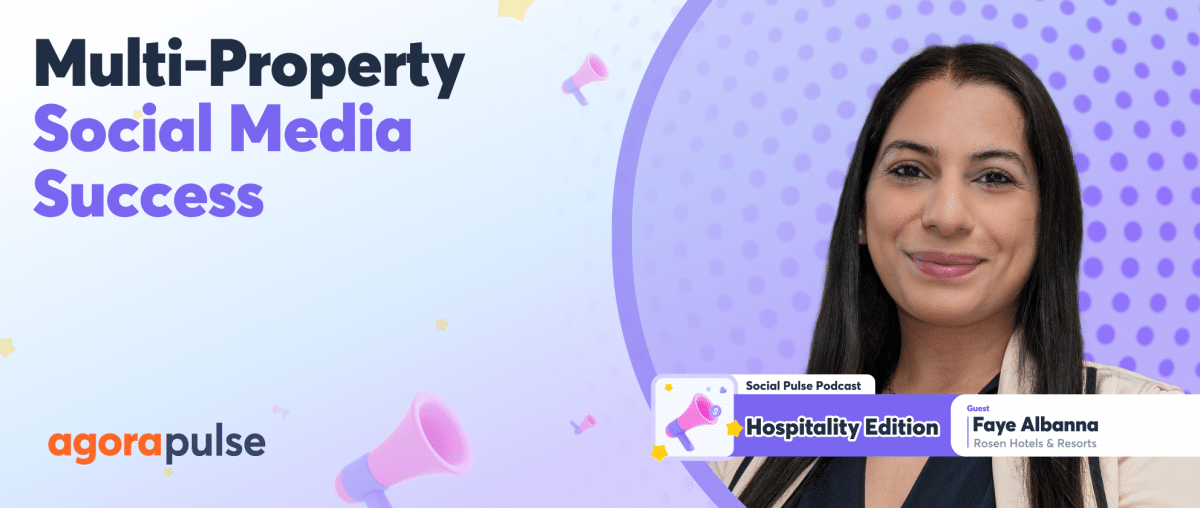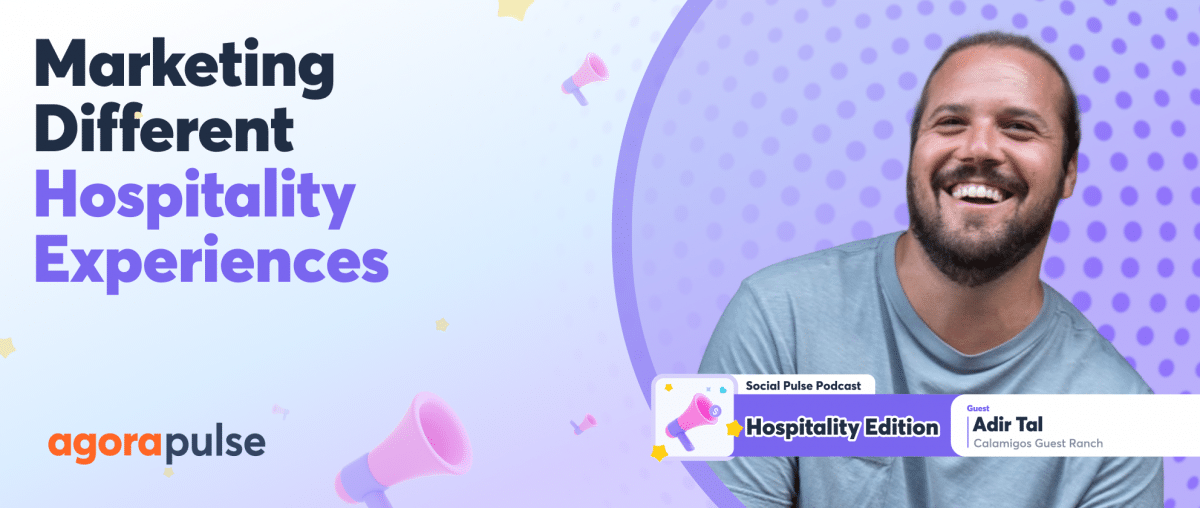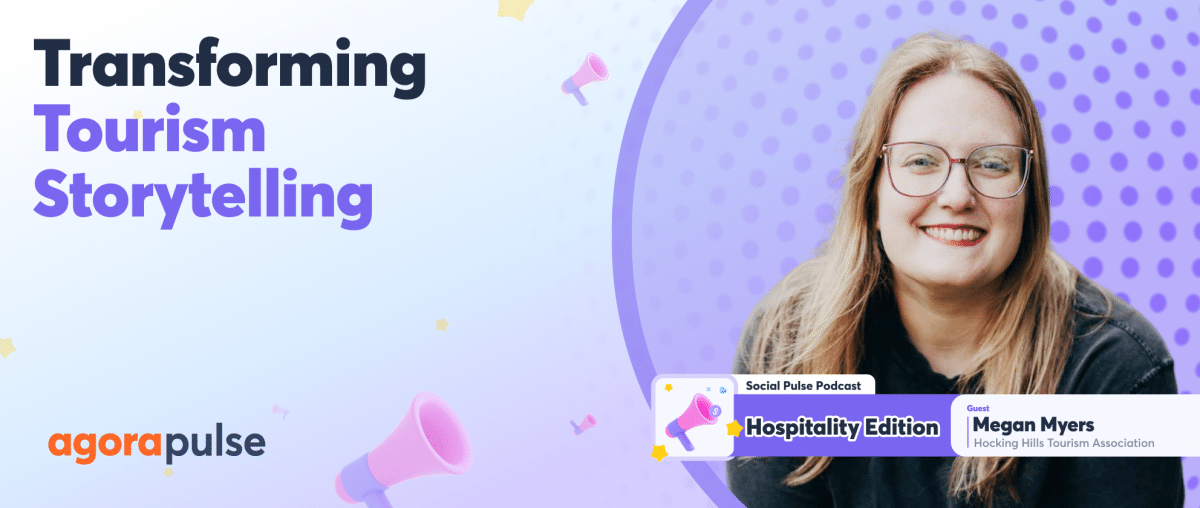Have you ever tried explaining something that has no direct comparison? In this recap of Social Pulse: Hospitality Edition with Agorapulse’s Chief Storyteller Mike Allton, our guest Stacy Feinberg shares what she knows about that challenge. As a former educator turned social media professional, she’s taken on the task of marketing luxury glamping domes that combine the comfort of high-end accommodations with immersive outdoor experiences.
[Listen to the full episode below, or read along for the transcript of the Social Pulse: Hospitality Edition, powered by Agorapulse. Try it for free today.]
Tell us about your journey from education to becoming the social media manager for Clear Sky Resorts
Stacy Feinberg: Sure. I was invited to teach in a fifth grade during COVID, and I was teaching online and all of the things that came with that, and it was a new school to me and a new curriculum and a new format, and I had just had enough of the whole process and I was looking for something new to explore, a new opportunity.
And lucky for me, my husband, Hal, was creating this wonderful resort, Clear Sky Resorts, and somehow, through COVID, he got this built. Our first year open was 2021. I stepped up out of need. It found me, but it turned out to be the perfect thing that I had been looking for some way to express myself creatively and to showcase and get out the word about this awesome new resort that we were opening during COVID.
But it turned out it’s the perfect destination because you can be in your dome. We have a keyless entry, and we wanted to bring that to the forefront, and with our budget, we knew the best way to do that would be social media.
So I stepped forward out of love for the project and looking for a new challenge, and it’s just been going since then.
View this post on Instagram
Tell us about Clear Sky
Stacy Feinberg: Clear Sky Resorts is a glamping dome experience. Our first location is by the Grand Canyon, so we have a location in Arizona.
That’s our original concept. It is more of a traditional canvas dome that you’re used to seeing, but it has wide-open panoramic windows and skylights in every dome above your bed for stargazing. But at the same time, the usual experience you’d get with a glamping dome does not include air conditioning and heat, a private bathroom inside every dome, and a full-service resort experience, which is what we offer.
We have activities, we have family events, we have all kinds of things like that. And we just, this year in August, opened our second location in Utah near Bryce Canyon National Park, and that location is a glass-front dome. So they’re like glass and wood. And so the front panoramic window is all glass, and you can just open up your curtains and lie on your bed and gaze out at the stars.
And there’s a lot of glamping out there, and there’s a lot of Airbnb domes, but we’re the first full-service luxury glamping experience we have. We have different numbers at each place. We have 44 domes at the Grand Canyon and about 60 domes at Bryce Canyon. But we have food at each property. We have stargazing tours. We have a full-service front desk. We have customer service, hospitality, housekeeping, and all the things you might expect. So it’s like you took a four-star hotel room and popped it down in the middle of the desert, which is something nobody else is doing.
What were the initial thoughts that you had from a social media strategy and content perspective for such a unique concept?
Stacy Feinberg: Oh, I had no idea coming in about what to expect!
I just knew I had a lot of love for the project, and I was excited to let people know.
And social media is a very effective, cost-effective way to educate people about your product. And so we wanted to have a strong social media presence, and we still have about a home office staff of about three and a half people. I just stepped into that role.
I thought it might be just what I was looking for.
How do you think your background in education has influenced your approach to social media content creation?
Stacy Feinberg: It’s interesting. I didn’t know that there would be so much overlap, but there is in social media, as in education these days, you need to grab people’s attention.
You have, according to my analytics, about two seconds on TikTok to grab someone’s attention and get them to notice you. So, it’s about the same in the classroom nowadays, it seems, and you grab their attention and you have a clear set goal in mind, and then you break down your concepts and present them to the audience in the way that you would like to present them.
And then you take a step back and you say, “Did that work?” Like, you have to assess and interpret your data and then adjust your style to build your relationships in the classroom or online. You build your relationships.
I think the number one thing that’s the same is just to repeat yourself over and over again. You think they have the concept, and then you get a question that you’ve just answered. And you just constantly need to be reinforcing your ideas, sticking to your goals, and focusing on your content.
So, I think there’s a lot more overlap than I expected.
View this post on Instagram
What other social channels are you focused on?
Stacy Feinberg: We’re on every channel. I have recently been trying to learn about Pinterest, which is of interest to me, but to be honest with you, I have no idea how Pinterest works, but I love TikTok.
TikTok has been great. We’ve been growing a lot there. We’re also the strongest on Instagram. Instagram is our bread and butter. So Facebook ads have been very productive for us. So we’re on Facebook, but Instagram and TikTok are where most of my attention is focused most of the time.
Mike Allton: I could see the nature of your destinations would play very well with Instagram and TikTok with Pinterest, which you’ll want to be thinking about, just some of the advice to you is that the people who are on Pinterest, planning their next trip or vacation or a hike, something on those lines.
So, you could think about pinning content that would be helpful to them, and it would bring your destinations to their awareness. And then they could [be like] “Oh, okay, cool. I can stay at Clear Sky for this trip.” And then they would pin that to their board, which they’re creating, probably a personal private board to help them plan their next trip to the Grand Canyon or Utah. Something along those lines.
Stacy Feinberg: Which would be great because we don’t want to get lost in the shuffle. We know there are a lot of great places to stay in very beautiful areas of the country, but we are fortunate; in my opinion, we have a very Instagrammable property. There’s just no end to natural beauty.
And then our domes at Bryce Canyon are very beautiful. Our domes at Grand Canyon, some of them are themed domes. We have an 80s game room dome. It’s just adorable and makes me feel so happy. And we have a Pac-Man decorated, and we have a game table that you can play, and so there’s a lot of opportunity for people to post us. And so that works in our favor, too.
What role would you say that audience feedback plays in your strategy, and how are you finding and surfacing that feedback?
Stacy Feinberg: It’s huge.
Audience feedback is huge because every single follower or potential follower refers to us as a potential guest, and so we want to give people what they’re expecting.
We want to make sure to set their expectations correctly. And so if I’m getting a lot of questions about something. I need to provide clarity on that so that we can provide them with an authentic representation of what to expect when they come to Clear Sky Resorts, where sometimes people come and they say, “This looks nothing like I was expecting.”
And that could go either way. So we want to be careful, and we want to set people’s expectations. And so their feedback is like, “How [do] I operate my comments?” I get DMs. I take everything to heart, so we can move forward authentically and provide clarity for them on their frequently asked questions.
How do you balance the need to educate people and try to create content that’s engaging and visual?
Stacy Feinberg: Again, I have about two seconds to get anybody’s attention.
So, lecturing is not an option. I just need to—I like going back to teaching. I need to meet people where they are and assess their prior knowledge. Like we call it KWL, what do they know? What do they want to know? And then what have they learned? It’s my job to put all that together.
And one of the things I love to do is I love to use Instagram Stories for this because you can put anything in a story. You can do polls, you can do a Would You Rather? You can do an Ask Me Anything (AMA), one of my favorites.
Besides being super engaging, it also just gives you a great picture of what people want to know. And so then you can take that, and you can create from their knowledge gaps, you can answer it in the story, but then you can also create a Reel or a TikTok or what have you about the topic that they’re asking about.
Then you also can take that and run with it, because not everybody learns the same way, and some people have to hear things a lot of times before they get it. So you have the ability to create that in a lot of different ways and a lot of different styles. Change the hashtag, change the font, and you can just get your content a lot of traction that way. Again, like you said, listening to your audience.
Mike Allton: I love the AMA tip. That’s huge. Folks, let that sink in ’cause they’re talking about Marcus Sheridan‘s approach, which is a classic approach to content marketing. They Ask, You Answer, it’s fundamental. It’s something that a lot of us as marketers lose sight of. We get enamored with campaigns and shiny objects and new platforms like Blue Sky and so on, but at the core, we need to be asking our audience to tell us what they want to know about. And so then we can answer those questions because it’s great content for the individual that asked it. But there are a hundred people. 10,000 people also have the exact same question, and you’ll help them whether it’s when you answer it tomorrow or if it’s in a long-form piece of content, like a video. They might stumble on that months from now, or they might find it on Pinterest and somebody else’s board, like, oh yeah, that’s exactly what I wanted to know. So, I love that tip.
Are there any strategies that have been helpful for helping potential guests understand what makes your resort so different?
Stacy Feinberg: It’s all kinds of the same answer because short-form videos are great. And like you said, especially on TikTok, they just resurface.
And when someone’s looking at you and researching your property, then those come out to the surface, and just repetition. Our frequently asked questions are frequently asked, so there’s some content that I just seem to focus on more than others, and a lot of times we’ll get something like someone will think that it’s an Airbnb, and so they won’t be understanding the exact concept that when you come here, we’re going to provide you live music and stargazing tours and horseback rides. Some people might not want, which might not be what they want. But again, setting expectations. When you come here, we’re not just offering you this bare bones Airbnb or this bare bones glamping. There is air conditioning in the domes, and there are these opportunities and experiences that we’re providing that no one else is providing in the industry.
It’s like you said, there are things that sort of remind you of it, but are not exactly it.
Mike Allton: No, that makes a lot of sense.
One of the early interviews we had was with a hotel chain on the East Coast and mostly around Philadelphia, where you could say they were like an Airbnb, but not really ’cause they had individual properties without a normal hotel front desk kind of a scenario. But it’s also fully managed and concierge, and the whole thing. And so it’s hard to communicate those, and your point is a hundred percent valid. That’s where the repetition comes into play.
How are you measuring success?
Stacy Feinberg: It’s been interesting that we’re using all the regular ways data from our website and Google, and when people call the resort to make a reservation, we ask them, how did you hear about Clear Sky Resorts, and what made you interested in us?
And so we have a lot of anecdotal evidence, but the thing that’s been interesting to me is that sometimes I’ll have a video hit on Instagram, and it’s immediate, the spike in bookings is absolutely just real-time data coming at me. A video got a million views, and we got a hundred bookings. It’s just been crazy to see.
But we do track data from our website and all the traditional ways that we look, and I try to see what is working for me on Instagram. They have great analytics there, and our meta analytics, we use that a lot. So we just gather as much data as we possibly can, and it’s been a lot of trial and error, but we’ve had a lot of success.
So it’s been very interesting to see.
Mike Allton: It’s a challenge because, unlike retail, you’re not necessarily sharing links with link posts. You don’t necessarily have a shop where you have that kind of direct one-to-one data. We know that this person clicked on this post and signed up, so it’s very much a let’s make a dotted line and hope we see some results stemming from those viral videos. So that’s awesome.
Stacy Feinberg: We can do that on our ads. Facebook makes that very easy to see. It links right to our cloud beds, and you can book, and we can see what ads are working, but you’re right, as far as regular posts, it’s a little, it’s a little trickier. I can see who clicks on my link tree and who goes where, but to follow them, to connect the dots is a little bit harder.
Are there any resources or communities that you turn to for inspiration or staying current in social media trends?
Stacy Feinberg: I am on Instagram all day long and TikTok, looking for inspiration and seeing what the trends are, and checking creators.
And I’m enamored with the business suite on TikTok right now. It’s very useful. You can niche down so far, you can niche down. So I’ll go on and I’ll go to the travel section, and it will show me a list of industry leaders and what they’re doing on their accounts. And then it will show me the hashtags that are performing, and it will show me the music that’s performing. And those videos have been doing well for us on TikTok. So, that’s my latest obsession, and I’m learning how to work with that.
But a tool that we use that isn’t necessarily a tool, maybe, but we collaborate a lot with influencers, so our property is Instagramable, and we love to do a lot of work with local influencers because they know their target audience and what they want to see.
And so they come and they stay and they take some beautiful videos and then they get the word out. And so it’s been great collaborating.
Influencers, too. That’s been a great resource for us and user-generated content as well.
So, we’ve been leaning on our community in that respect, and I’ve been learning a lot from those people, too.
Thank all of you for reading the highlights of this episode with Stacy Feinberg. Don’t forget to find the Social Pulse Podcast: Hospitality Edition on Apple, and drop us a review. We’d love to know what you think. Don’t miss other editions of the Social Pulse Podcast like the Retail Edition, Agency Edition, and B2B Edition.
